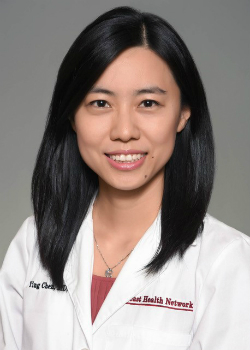
AJR December 2018
 
|
Ying Chen and Shinn-Huey S. Chou
Massachusetts General Hospital
Boston, MA
|
“Value of Mammography for Women 30–39 Years Old Presenting With Breast Symptoms”
Breast ultrasound should be used as the primary initial imaging modality in the evaluation of a focal clinical concern in women 30-39 years old, according to an article in the December 2018 issue of the American Journal of Roentgenology (AJR).
The study showed that bilateral mammographic evaluation of women 30-39 years old presenting with breast symptoms yielded an additional 2.0 incidental cancers per 1000 examinations. Women with diagnoses of incidental breast cancer in this young population were at higher lifetime risk of breast cancer than their age-matched control subjects, nearly 70% presenting with identifiable risk factors.
The findings support American College of Radiology (ACR) and European recommendations for targeted breast ultrasound as the initial imaging evaluation of women 30-39 years old who have symptoms and support bilateral mammography added to ultrasound for women with risk factors for breast cancer and as an adjunct examination when suspicious or indeterminate sonographic findings are present.
The study reviewed more than 4,000 diagnostic examinations of women who underwent mammography and ultrasound between June 2006 and August 2016. Outcomes were determined by imaging and pathologic analysis through linkage with a tumor registry. Medical records were reviewed to determine the presence of breast cancer risk factors.
Of that group, 68 breast cancers were diagnosed for a cancer detection rate (CDR) of 15.4 per 1,000 examinations. Sixty examinations led to biopsy of a finding distant from the presenting symptom site, yielding nine incidental malignancies with a CDR of two per 1,000 examinations. In the study group, targeted breast ultrasound had 98.3% sensitivity for cancer detection in the symptomatic area with 100% negative predictive value. These results are consistent with previous research findings showing high sensitivity of targeted ultrasound in the evaluation of young patients with symptoms.
In this Q&A, coauthors Ying Chen and Shinn-Huey S. Chou of Massachusetts General Hospital discuss the ideas behind the study and the outlook for further research.
What is the background for this study? How did you and your co-authors come up with the idea?
Chen: Management of women at age 30-39 years who present with focal breast symptoms has been challenging. The current ACR appropriateness criteria recommend either mammogram or ultrasound as the first imaging modality at the discretion of the radiologists. Research has shown that targeted ultrasound is highly sensitive to diagnose breast cancer at the site of presenting symptom. However, if the targeted ultrasound were to be used as the primary imaging modality in this setting, we didn't know the magnitude of benefit of mammogram in diagnosing cancer away from the area of presenting symptom. Therefore, we decided to quantify the value of mammogram in this clinical setting and hoped the results would provide further guidance for practice.
Chou: When we discussed this subject with colleagues across the country, we found that radiologists vary in our practices in the management of women ages 30-39 presenting with clinical concerns of the breast, all in accordance with the current ACR appropriateness criteria recommendations: some perform mammogram first in all women ages 30 and above; some perform mammogram first in women ages 35 and above, and ultrasound first in women under age 35; some decide on a case-by-case basis, etc.
As women in this age group, we want to know first and foremost how good the imaging tests are at addressing our biggest concerns that brought us to the radiologists. As breast radiologists, we want to know how confident we can be to reassure our patients and ease their anxiety if the imaging tests are negative and to identify worrisome findings if the patients do have breast cancer. Multiple studies including ours have shown that targeted ultrasound is highly sensitive and mammogram is less so for this purpose. So, our question is: If ultrasound is highly sensitive in addressing our clinical concerns, what are the added benefits of mammogram, which is a less comfortable exam, for women in this age group?
What should readers take away from your article?
Chen: Our study supports prior research that targeted ultrasound is highly sensitive, more sensitive than mammogram, in diagnosing breast cancer at the site of symptom in these young women. The cancer detection rate by mammogram at the area away from the symptom is low. The vast majority of these women who ended with diagnoses of breast cancer had identifiable risk factors; the most frequent risk factor was family history of breast/ovarian cancer. Therefore, it may be sensible to employ targeted ultrasound as the primary imaging modality for women aged 30-39 without risk factors, and reserve mammogram to those with risk factors.
Chou: Most of us already knew that if mammogram is performed first and negative for any finding accounting for the clinical concern, then an ultrasound should generally follow. If ultrasound is performed first or it is the only available imaging test, it has a high sensitivity and negative predictive value. However, there are certain scenarios where mammogram would be very helpful and important to further evaluate the area of concern, particularly when ultrasound demonstrates a suspicious or indeterminate finding. Furthermore, even when the area of clinical concern is shown to represent normal tissue or benign findings such as cysts, mammogram can show findings that are separate from and unrelated to the area of concern, which turn out to be two cancers per 1,000 exams in this age group. The majority of these 30-to-39-year-old women who are diagnosed with breast cancer had risk factors.
What recommendations do you have for future research as a result of this article?
Chen: This is a single institution retrospective study. We hope to see the multi-institution research and prospective study on this topic.
Chou: We would also like to see future research investigating long-term outcomes of these women, particularly disease-specific and overall survival. It would also be interesting to explore the preferences of women in this age group, when presented with our data including additional cancer diagnosed by mammogram, follow-up and benign biopsies recommended due to mammogram, and the options of ultrasound or mammogram first.
Do you have a story idea for InBrief?
Contact Mike Mason, Communications Manager, at mmason@arrs.org for more information.